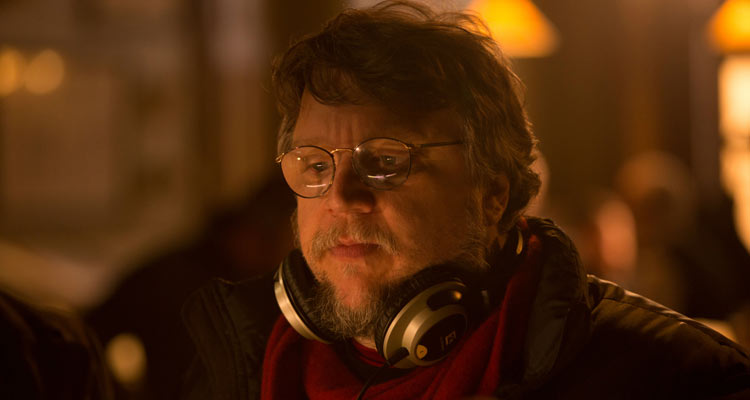A few days ago I had the pleasure of being part of an intimate press conference in New York with the cast and the filmmaker behind the new Universal Pictures film CRIMSON PEAK.
Read below what writer-director Writer-director Guillermo Del Toro had to say about his Gothic romance, including some details that may be considered minor spoilers.
CRIMSON PEAK opens in theaters nationwide this Friday, Oct. 16.
Desde Hollywood: Could you please talk a about your inspirations behind “Crimson Peak”?
Guillermo Del Toro: All my life I read these novels like E.T.A Hoffman, Ann Radcliffe, Matthew Lewis, the most famous, and the Gothic impregnates literature all the way to our day. It resonates with Charles Dickens in “Great Expectations”, it resonates with Jane Austen and Northanger Abbey, it resonated and reconverted by Henry James in “Return of The Screw.” For a while it was the most popular form of literature in Victorian England to the point that there is an engraving of two ladies in a parlor reading “The Monk” and another one looking so that no one enters because it was full for Victorian era, full of sex and violence and there were very articulating elements and they were rebelling against academia.
I fell in love with this spirit. I happen to be a filmmaker that is not postmodern, I’m not ironic, I am completely high on my own supply, every thing I do with a passion earnestly. I love that spirit and that’s the spirit of romanticism. I thought the era the Victorians were enjoying the peak of Gothic romance, they were afraid to talk about sex. Now I think we are afraid to talk about love, it becomes a corny emotion, it becomes cold, distant and aloof and I thought it would be great to talk about a Gothic romance about love, about what is love really and to switch it into a more female-centric, gender political arena. Normally these girls are all rescued by Fabio, they go to the cliff and they catch a ship to a romantic island. No spoilers, but I wanted the girls to take charge of themselves, to apply their confidence. The important thing about Edith’s love story is to survive and love herself. In these movies sex makes women victims, or dooms them, and I wanted sex to be used in a liberating way for both characters and not to use it as a gage of purity, which I find to be completely a male centered obsession.
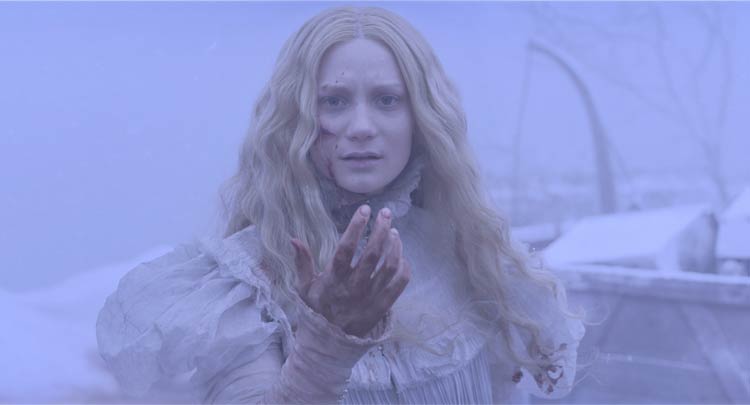
I loved when Mia said things like “Wait here! I’ll comeback for you, I promise you.” That’s the line that guys say to girls in movies and I really love these things. I had such a crush on Mary Shelley and all of the Bronte sisters because I thought what remarkable beings they are, they were magical while I was growing up, I thought the complexity and psychology of Jane Eyre, I love that she falls madly in love with this man but he cannot tie her in spite of everything. To me it was mind-blowing when Mary Shelley wrote the novel when she was a teenager, when women didn’t get published as easily as men did.
“Crimson Peak” takes place in 1901, and I called her Edith for Edith Wharton, because she both embodies the spirit of that particular period, which is modernity, but she also is in my opinion as good a writer as Henry James, with whom he had a good literary relationship. Also, she writes this oblique ghost story, and I don’t want to use ghosts in the normal way, whether they are evil or demonic, I want to use them in a way Henry James described Gothic romance. Henry once said Gothic romance “the ghost represents our past that immobilizes us from moving into the future.” I’ve been obsessed with these things since I was 11 years old. There is a whole shelf in my house related to Gothic romance, my entire room that’s called the Dickens room is where I sleep. It’s all Victorian spectacles, fever, con-men, criminal low lives, the criminal code of Victorian England. Until I do “Pacific Rim” no one can tell that I love Kaiju and Mecha; until I do “Crimson Peak” no one can know that I love [Gothic romance]. For me it’s a way of communicating with the people that like what I do, this is another thing we can talk about and explore.
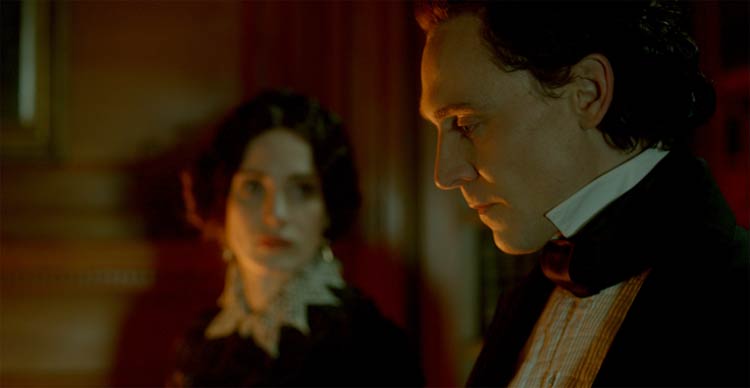
Desde Hollywood: Talking about “Pacific Rim” my favorite Kaiju has to be Otachi. I noticed that he has a feature where he has a mandible; do you somehow make a reference to other horror figures like Jared Nomak in “Blade 2”?
Del Toro: A filmmaker shows proclivities in movies, it’s like image-fetishism, and the things you like are the things you like. I’m a guy who can go to the same restaurant everyday and don’t get tired of it, my assistant may vouch for that. I can eat the same food for 20 years and not complain, and it’s the same thing with images. You end up liking what you like. I gravitate towards themes and images that are similar and the same thing with the sense of design I tend to design with. The robots in “The Golden Army,” they have this sort of insect mouth. I like things that move and make noises. We designed the monsters already for “Pacific Rim 2” and one Kaiju had a splitting feature, but bigger. Much bigger.
Question: The Allerdale Hall was a real scene-stealer. Did you have a character biography of the house, like the ones you gave to the principal actors?
Del Toro: The biography I did for the characters, were immediately passed through the wardrobe design and the production design because I don’t do eye candy, I do eye protein. I told them “You really have to embody this biography and what they wear, what we see them live in.” America 1901, Buffalo NY, which is where the movie takes place, was the most electrifying city in the world. Nikola Tesla had just electrified the city. You see modernity, cars, type writing machines, steam engines and electrical lights. It’s the most cyber city in that time. Edith is a woman that says “I don’t need love,” but she’s never been in love. She then falls in love and doesn’t know what it is and Thomas says that it’s imperfect, and that is the golden period. Then you go to Allerdale, it’s curves and Gothic shapes, Gothic revival but the back of the house is done in medieval style because the base of the house was in abbey. The cellar is Romanesque, then they covered it with tile, then the abbey got remodeled and then they built the front of the house, which was the McMansion, and then went with the most opulent style at the time which was Gothic revival. Now Gothic revival is super swanky, so then they cannot afford to make repairs and the ceiling would rot. That’s telling you the grand story with a hole in the heart, it also tells you how screwed they are economically. They have one servant, a 90-year-old guy who’s really confused. The house is full of details, negative shades that look like humans, the corridor and everything around it is photo-referenced, even the corridor spikes is referenced from a Victorian book.
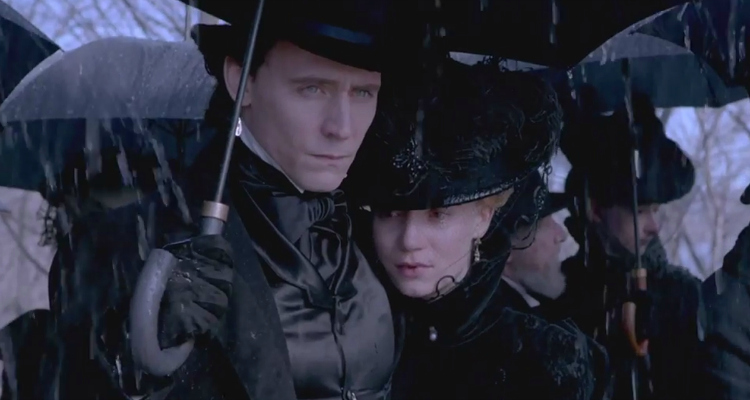
Question: Pacific Rim is on an indefinite hold, do you feel confident that the project could be up and running in the near future and if not do you have a back up project?
Del Toro: I’m actually going to do another movie before, “Pacific Rim” it’s not dead, it could be, and it’s above my pay grade to declare a movie going lit but we are delivering a budget and screenplay that fits the budget in three weeks then they can decide. In the meantime I’m going to do a really weird small movie, and sort of rest and I’ll come back to something else. I found out for some reason my projects get announced publicly, rapidly, and then when they don’t happen then they announce that it doesn’t happen publicly. What I found in my life is that if you want to make God laugh tell them what your next movie is.
Question: Do you have an upcoming film that you’re planning to do in Spanish and also, when you make that choice is it in service of the story or does it have to do with what studios want?
Del Toro: When we were trying to finance “Pan’s Labyrinth” a lot of people said “we would give you double the budget, but do it in English,” and I said “I can’t” because I hate those movies where people should be talking in a native language and they’re speaking in English. You can do it in certain genres, I knew the next step would be for them to want an English actor or an American actor to play the captain, it’s downhill from there. You do the movies in the budget that you need and the way you imagine them, there’s not an agenda, but something smaller and something bigger is good. To go and change sizes is really good because it keeps you on your toes. You don’t get used to the big budgets. “Pacific Rim” was $190 millions, while “Crimson Peak” is $50 millions, and for me “Crimson Peak” looks gigantic too. To me a budget is partially real and partially imaginary, if you go back in time to your own 25-year-old self you tell me I’m going to give you $3 Million I could probably do “Robot Apocalypse” or something. It’s something you need to adjust.
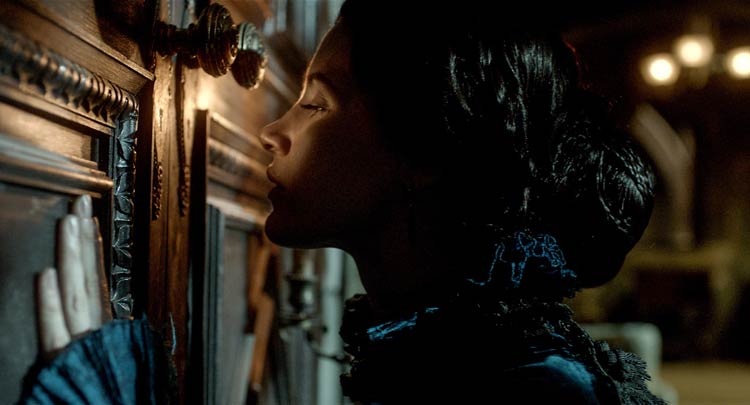
Question: What do you think are some of the basic elements to turn a horror film into a classic and what films do you think would make a great double feature with “Crimson Peak”?
Del Toro: To me “Crimson Peak” is not a horror but a Gothic film, a combination of dark fairy tale and supernatural elements and drama, It’s a very beautiful mixture, it’s like sweet and sour chicken, it is flavor that shouldn’t go together but they go together since the inception of the genre. Horror is like humor or erotica; your horror is not my horror, you can tell me it’s the funniest joke or what peels your banana doesn’t peel mine, it’s completely subjective. The rules are very simple, absence or presence: you come in to you kitchen and dad is there making some scrambled eggs and that’s not scary at all. Your dad died six months ago then it’s scary, it’s context, it shouldn’t be there. On the other hand, you leave the car to close the door, your daughter is in the car and you come back she is not there. That’s absence, that shouldn’t happen.
Question: I noticed you shot some scenes in 180 aspect ratio for more intimate scenes, what influenced that decision?
Del Toro: I always shoot in 185. For me it is closer to the golden measure for composition. It is somewhat easier for me, the scope format where a result of the competition between cinema and television and they were ultimately created and some of the greatest classics on earth including David Lean’s “Great Expectations” are square formats because that was a format that the movies were done and he has a few vistas in “Great expectations” that are breathtaking. But I think that scope is amazing for exterior epics like adventure movies or western. But 185 gives you a little more of the Gothic arch and height that you need and I’ve always been enamored of 185. I can do a nice wide shot, for example in “The Devil’s Backbone” you see there is a stabbing scene in the middle of a field, there is a beautiful wide shot. I think I would love to shoot “At the Mountains of Madness” in that scope, but “Crimson Peak” felt very clear to me at 185. The movies I was trying to recuperate at the same time are modern and old-fashioned, big Hollywood spectacle, those movies were 185 or even squarer.
CRIMSON PEAK will be released in theaters on Oct. 16.
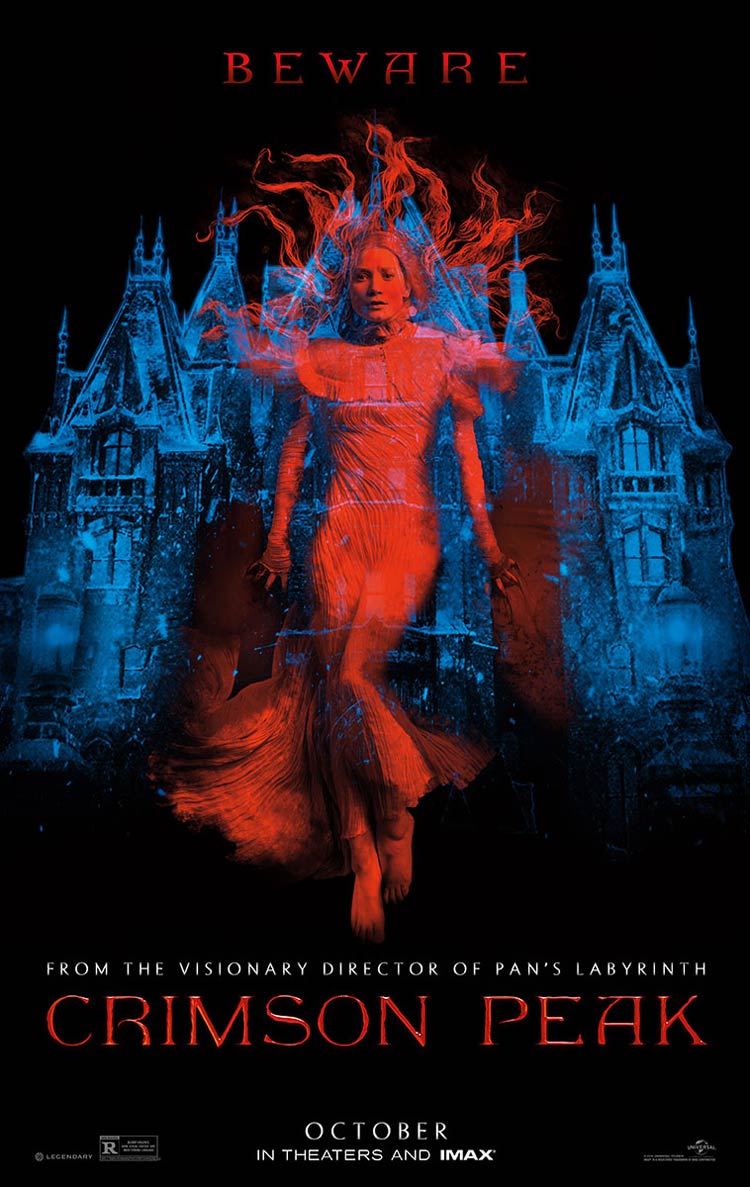
When her heart is stolen by a seductive stranger, a young woman is swept away to a house atop a mountain of blood-red clay: a place filled with secrets that will haunt her forever. Between desire and darkness, between mystery and madness, lies the truth behind Crimson Peak.





